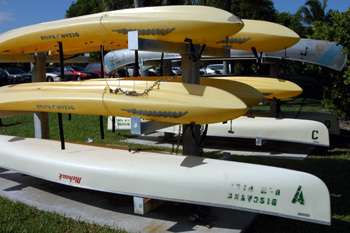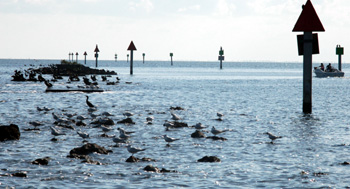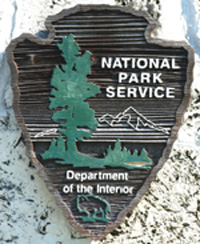
Park kayaks, canoes offer unique tours
HOMESTEAD, Fla.— The tangled mess of mangrove roots disappeared below the afternoon sun-soaked surface of seawater. My oar broke the glassy monotony of the water’s surface sending slivers of light bouncing in obtuse directions.
The pull of my oar slipped my kayak past an opening in a section of mangrove and I found myself in an Eden of quiet water and mangroves. I dipped my oar into the soft mud, less than a foot below the surface and took a deep breath, enjoying the serenity of my moment with nature in the Biscayne National Park.
 |
These canoes and kayaks may be rented at the Visitor Center at the park headquarters (Staff photos). |
My mellow mood was interrupted by the exclamations of my best friend, and kayak companion for the day, Hunter Seidman.
“Dude, when are we going to hit the rapids,” he jubilantly shouted, no doubt imagining the barrel rolls that he was sure to soon try.
His adrenaline-filled ideas were reluctantly pastured as I explained to him that we were here to enjoy the exotic mangrove ecosystems of Biscayne National Park, and that the only rapids we would encounter were from the wakes of tour boats leaving the marina.
“You mean, you got me up early to look at these lousy trees,” he clamored, almost losing his balance as he used one end of his oar to point at a section of mangrove.
I ignored the fact that his “early” was 12:30 p.m. and promised myself that by the end of the day he would appreciate mangroves as much as I already did.
“The park ranger said that there are barracudas in here. See if you can spot some,” I said to change the subject.
He excitedly pushed off the bottom with his oar and paddled off in pursuit of the silver carnivores, leaving me time to take pictures and enjoy the things that the park ranger had told me to look for.
Hunter and I had driven down to Convoy Point, the park headquarters, on a Sunday.
Convoy Point is about one hour south of Miami. After perusing the Dante Fascell Visitor Center, while Hunter napped in the car, I spoke with Maria Beotugui about exploring a section of the 14 miles of the park’s mangroves by kayak.
We had rented two kayaks for two hours, for $16 per hour per kayak.
 |
Seagulls, pelicans, and other wild birds wait in shallow bay water for a meal. Locations are easily reached by canoe or kayak from the Visitor Center. |
We were provided with two sit-on-top kayaks and bright orange life jackets.
I listened to a quick briefing by the park ranger on the kayaks and the mangrove system, while Hunter lathered his Casper-like skin with a lotion that exceeds the maximum on the SPF scale.
We hurriedly donned our life jackets and slipped into the water, anxious to try out the kayaks. We had opted to get one kayak each, as the combined lack of coordination of the two of us would have rendered the kayak destined to capsize. The kayaks were surprisingly maneuverable and, considering that you sit on top of them, also very buoyant.
“I think I saw one!” Hunter yelled, and paddled off in another direction, his hunt for the barracuda apparently successful.
I was busy orienting myself with the mangroves, trying to put together what I had learned from reading about mangroves and what the ranger told me with what I was looking at.
Mangroves are a unique ecosystem that exist in Biscayne National Park, protecting the delicate bay waters from the mainland and vice-versa. Mangroves grow at the edge of the land into the brackish water, a mixture of salt and fresh water, making for an unusual habitat.
The bay is protected from land runoff and pollutants from the mainland, as the web of mangroves trap soil forming islands around their roots. The resulting barrier also provides protection for the mainland from wind and waves created by hurricanes, a vital symbiosis only recently understood by scientists.
The mangrove is also a sanctuary for juvenile reef and sport fish, which feed on the bacteria that decompose the dead leaf material of the mangroves. These fish find protected shelter in the nest of branches and roots that knot themselves in the warm water.
Again Hunter broke my focus as he paddled into sight with a very dejected look on his face.
“What happened, no barracuda?” I said, predicting his situation.
“The water is too dirty. I can’t see anything.”
I took the opportunity to impress upon him the knowledge I had gained while he had been catching up on sleep in the parking lot.
“It’s not dirty, its tannin. It leaks in from the tree. It’s what gives it that tea color,” I said matter-of-factly.
Hunter rowed closer, knowing that he was now in for a lesson on mangroves.
“What are the cigar-like things popping up over there from the mud?” he asked, knowing my answer would not be short.
The “cigar-like things” that Hunter was referring to are called pneumatophores. They are the roots of the Black Mangrove.
“They supply the mangrove with oxygen, which is absent in the thick mud,” I told him, remembering what Maria had told me.
Hunter reached up and peeled off one of the thick leaves from the mangrove. It was covered in tiny white crystals.
“I dare you to lick it,” I said, knowing well enough that he wouldn’t.
To my surprise he wiped his finger across the white surface and licked it, making a sour face.
“Salty,” he murmured.
“Exactly, the leaves have glands that excrete the salt from the water that is brought up through the roots,” I said, happy to have been able to provide an explanation.
I went on to explain to him more about the Black Mangrove and two other types of mangroves found in Biscayne National Park, the Red and the White Mangroves. I filled his head with all sorts of information in regard to the exciting ecosystem, and the animals that call it home.
After about 15 minutes, Hunter was bored and I was out of information, apparent in the fact that I had started repeating myself.
We continued paddling, following the mangrove shoreline and enjoying the afternoon sun, when once again my calmness was interrupted, though this time not by Hunter. I was visited by the Brown Pelican, one of the many birds who call these mangrove forests home. It swooped down next to me, swallowed a mouthful of water, blowing its “cheeks” up to a balloon-like proportion, then craning its neck back to swallow its catch.
Hunter and I were able to witness this three more times, as the pelican repeated the same action in close proximity to us before disappearing into the tangle of tree branches.
 |
| The park service’s famed arrowhead logo. |
We paddled around for a little while longer, our eyes trained just below the water’s surface looking for manatees, crocodiles and stingrays, of which Maria said we might encounter.
Except for a few mullet, not the redneck haircut, but the fish, we were out of luck. Our erratic paddling technique seemed to announce our arrival, long before we had a chance to witness whatever was lurking beneath us.
At around 3:30, we made our way back to the marina, a trip that lasted all of 10 minutes. The mangroves start right off the edge of the marina, so it does not take much paddling to observe them and we hadn’t ventured far from the dock.
The mangroves of Biscayne National Park are a fabulous opportunity to witness a mysterious ecosystem that has been preserved for our benefit. Rapids or not, the trip is well worth the effort.

Comments are Closed